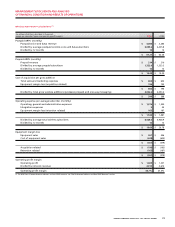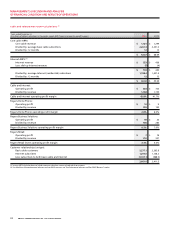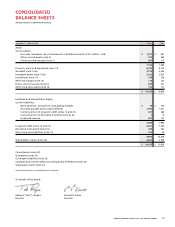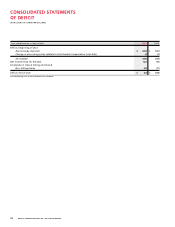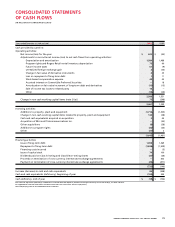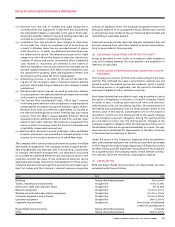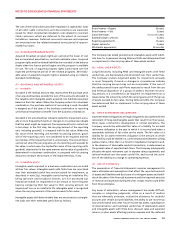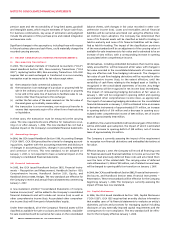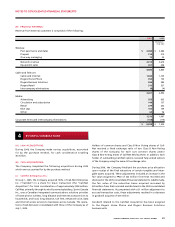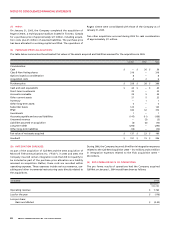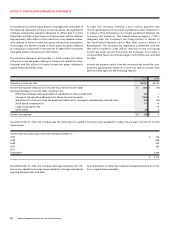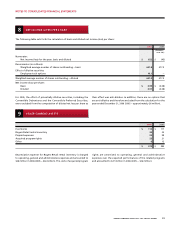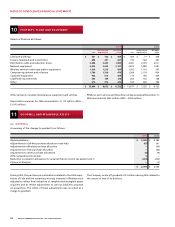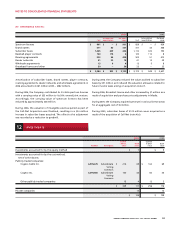Rogers 2006 Annual Report Download - page 87
Download and view the complete annual report
Please find page 87 of the 2006 Rogers annual report below. You can navigate through the pages in the report by either clicking on the pages listed below, or by using the keyword search tool below to find specific information within the annual report.
83
RO GER S CO MMU NIC AT ION S IN C . 20 0 6 ANN UA L RE POR T
NOTES TO CONSOLIDATED FINANCIAL STATEMENTS
The cost of the initial cable subscriber installation is capitalized. Costs
of all other cable connections and disconnections are expensed,
except for direct incremental installation costs related to reconnect
Cable customers, which are deferred to the extent of reconnect
installation revenues. Deferred reconnect revenues and expenses
are amortized over the related estimated service period of approxi-
mately four years.
(O) ACQUIRED PROGRAM RIGHTS:
Acquired broadcast program rights are carried at the lower of cost
less accumulated amortization, and net realizable value. Acquired
program rights and the related liabilities are recorded on the balance
sheets when the licence period begins and the program is available
for use. The cost of acquired program rights is amortized over the
expected performance period of the related programs. Net realiz-
able value of acquired program rights is assessed using an industry
standard methodology.
(P) GOODWILL AND INTANGIBLE ASSETS:
(i) Goodwill:
Goodwill is the residual amount that results when the purchase price
of an acquired business exceeds the sum of the amounts allocated to
the tangible and intangible assets acquired, less liabilities assumed,
based on their fair values. When the Company enters into a business
combination, the purchase method of accounting is used. Goodwill
is assigned as of the date of the business combination to reporting
units that are expected to benefit from the business combination.
Goodwill is not amortized but instead is tested for impairment annu-
ally or more frequently if events or changes in circumstances indicate
that the asset might be impaired. The impairment test is carried out
in two steps. In the first step, the carrying amount of the reporting
unit, including goodwill, is compared with its fair value. When the
fair value of the reporting unit exceeds its carrying amount, good-
will of the reporting unit is not considered to be impaired and the
second step of the impairment test is unnecessary. The second step is
carried out when the carrying amount of a reporting unit exceeds its
fair value, in which case, the implied fair value of the reporting unit’s
goodwill, determined in the same manner as the value of goodwill is
determined in a business combination, is compared with its carrying
amount to measure the amount of the impairment loss, if any.
(ii) Int angible assets:
Intangible assets acquired in a business combination are recorded
at their fair values. Intangible assets with finite lives are amortized
over their estimated useful lives and are tested for impairment, as
described in note 2(q). Intangible assets having an indefinite life,
being spectrum and broadcast licences, are not amortized but
instead are tested for impairment on an annual or more frequent
basis by comparing their fair value to their carrying amount. An
impairment loss on an indefinite life intangible asset is recognized
when the carrying amount of the asset exceeds its fair value.
Intangible assets with determinable lives are amortized on a straight-
line basis over their estimated useful lives as follows:
Brand names – Rogers 20 years
Brand names – Fido 5 years
Subscriber bases 21/4 to 42/3 years
Baseball player contracts 5 years
Roaming agreements 12 years
Dealer networks 4 years
Wholesale agreements 38 months
The Company has tested goodwill and intangible assets with indefi-
nite lives for impairment during 2006 and 2005 and determined that
no impairment in the carrying value of these assets existed.
(Q) LONG-LIVED ASSETS:
Long-lived assets, including PP&E and intangible assets with finite
useful lives, are depreciated and amortized over their useful lives.
The Company reviews long-lived assets for impairment annually
or more frequently if events or changes in circumstances indicate
that the carrying amount may not be recoverable. If the sum of
the undiscounted future cash flows expected to result from the use
and eventual disposition of a group of assets is less than its carry-
ing amount, it is considered to be impaired. An impairment loss is
measured as the amount by which the carrying amount of the group
of assets exceeds its fair value. During 2006 and 2005, the Company
has determined that no impairment in the carrying value of these
assets existed.
(R) ASSET RETIREMENT OBLIGATIONS:
Asset retirement obligations are legal obligations associated with the
retirement of long-lived tangible assets that result from their acqui-
sition, lease, construction, development or normal operations. The
Company records the estimated fair value of a liability for an asset
retirement obligation in the year in which it is incurred and when a
reasonable estimate of fair value can be made. The fair value of a
liability for an asset retirement obligation is the amount at which
that liability could be settled in a current transaction between willing
parties, that is, other than in a forced or liquidation transaction and,
in the absence of observable market transactions, is determined as
the present value of expected cash flows. The Company subsequently
allocates the asset retirement cost to expense using a systematic and
rational method over the asset’s useful life, and records the accre-
tion of the liability as a charge to operating expenses.
(S) USE OF ESTIMATES:
The preparation of financial statements requires management to
make estimates and assumptions that affect the reported amounts
of assets and liabilities and disclosure of contingent assets and liabili-
ties at the date of the financial statements and the reported amounts
of revenue and expenses during the year. Actual results could differ
from those estimates.
Key areas of estimation, where management has made difficult,
complex or subjective judgments, often as a result of matters
that are inherently uncertain, include the allowance for doubtful
accounts and certain accrued liabilities, the ability to use income tax
loss carryforwards and other future income tax assets, capitalization
of internal labour and overhead, useful lives of depreciable assets
and intangible assets with finite lives, discount rates and expected
returns on plan assets affecting pension expense and the deferred


